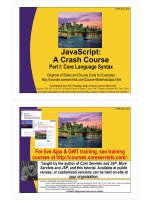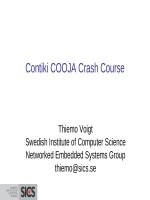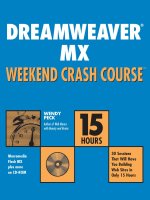linux crash course linux crash course virtualization
Bạn đang xem bản rút gọn của tài liệu. Xem và tải ngay bản đầy đủ của tài liệu tại đây (208.49 KB, 10 trang )
A Brief Intro to
Virtualiztion
What is Virtualization?
• An abstraction
• Usually performed via software
• Many different types
– Hardware
– Software
– Data
– Network
• Our focus will be hardware virtualization
Hardware Virtualization
• Abstracts underlying physical hardware from
operating systems and applications
• Allows multiple guest operating systems to
run in parallel
• Physical resources are shared amongst all
guest OS and virtualization software
Virtualization
Terminology
• Host Machine
– The physical hardware/server
• Hypervisor
– The virtualization software
– Acts as the true ‘OS’ for the server
• Virtual Machines
– Instances of the virtualized OS
– Sometimes called Guest OS
Why Virtualize?
•
•
•
•
•
•
Low CPU and memory utilization
Overpowered and overpriced hardware
Datacenter sprawl
Power and HVAC
High administrative labor costs
OS Licensing
Benefits
•
•
•
•
•
•
•
Fewer servers, with better system utilization
Easier redundancy and disaster recovery
Decreased downtime
Ability to leverage patch management
Greatly decreased build times
Excellent testbed
Sharing of pooled resources
Migration
• Converting a physical server to a VM often
called P2V
• New VM created from image of existing OS
and applications
• Turn off physical, start VM, done
• Rapid datacenter consolidation
Deployment
•
•
•
•
Create a new VM
Install OS
Install apps
Some products allow you to make templates
– Click, click, deploy, done
Products
• For the Enterprise
– VMware ESX/vSphere, Virtual Center
– Microsoft HyperV
• For the end user
– VMware Player, Server
– Virtualbox
– Microsoft Virtual PC









